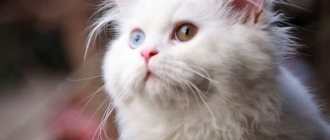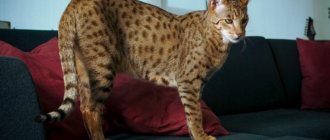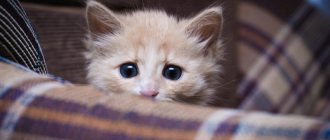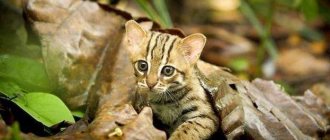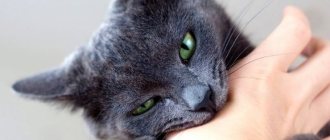Nebelung, a rare cat breed
- Fact 1:
Despite the fact that the ancestors of the modern breed are Russian Blues, breeding of Nibelungs began almost at the same time in different parts of the world. - Fact 2:
A distinctive character trait of the Nibelungs is a quiet voice and “lack of words.” - Fact 3:
Nibelungs are absolutely unpretentious and have good health. - Fact 4:
Nibelungs are also distinguished by good mental abilities.
Nibelungs are still a very young breed of cats, the breeding of which began a little more than 30 years ago. Their coloration indicates a close relationship with Russian Blues. Calm and independent animals are just beginning to gain popularity among cat lovers. These pets have good health, attractive appearance and calm temperament.
How the breed originated
The history of the origin of the Nibelungs is as ambiguous as their name. Some believe that the cats were named this way because of their color. Translated from German, this word means “creature of fog.” Indeed, the color of animal fur has a very beautiful smoky shade. According to another version, the breed received its name because of its creator’s love for the opera “The Ring of the Nibelungs.”
Despite the fact that the ancestors of the modern breed are Russian Blues, breeding of Nibelungs began almost at the same time in different parts of the world. In our country, Krasnoyarsk breeders were engaged in selection. They managed to breed kittens very similar to Russian Blues in color, but with long and silky hair. Relatively recently, cats of Russian origin were recognized by TICA. And several were even taken abroad to improve the gene pool of animals from America.
In the USA, Nibelungs were bred not by professional breeders, but by ordinary people . Programmer Cora Cobb once acquired a very beautiful kitten with incredibly beautiful bluish fur. It's amazing that such a baby was born from the union of a Russian Blue cat and an Angora.
After some time, the same pair of foundations had offspring. One kitten also had long hair. Cora bought it too. And soon she began to seriously think about breeding a new breed and brought together the purchased cats. At the end of the 80s. XX century unusual kittens have their first offspring. An American woman has applied to register the breed. As a result, by 2008, the Nibelungs were recognized by almost all leading felinological organizations - from TICA to LOOF.
History of the origin of the Nibelung breed
It all started when the creator of the breed, American Cora Cobb, allowed her cat to accidentally breed with a Russian Blue cat. The cat gave birth to kittens; the litter included long-haired blue kittens with a silver tint. The American liked the appearance of long-haired kittens so much that she turned to a professional geneticist, and, with the help of a specialist, continued to breed a long-haired version of the Russian Blue breed.
Later, when work on the stability of reproduction of long-haired blue kittens in litters was completed, the breeder applied to the International Cat Association TICA for recognition of the new breed. The Nibelung breed standard was developed in 1987.
Interesting! The Russian Blue cat was approved as an outcross for the new breed, which made it possible to further rely on this breed for the development of the gene pool. The gene for long hair in Nibelungs is recessive, and the carriers of the gene are Russian Blue cats. Accordingly, to improve the quality of the gene pool, short-haired Russian Blue breeds are crossed with long-haired Nibelungs.
General description of appearance
Cats of this breed are not large in size. They have a slightly elongated body with well-developed muscles. The physique is strong, but not massive. Nibelungs give the impression of graceful, graceful animals. They always seem a little larger than they really are due to their abundant fur.
The cats have a medium-sized head and a wedge-shaped muzzle with a flat forehead and a strong chin. A characteristic feature is the strongly pronounced whisker pads. The ears are large and rounded at the tips, always slightly tilted forward. Due to the peculiarities of the structure, they appear almost transparent.
Acceptable eye color is bright green or amber. Although the latter is less common. The nose is always gray-blue, and the paw pads are gray-pink. Cats have long legs and oval paws with tightly clenched toes. The tail is always long and fluffy with a rounded tip.
Breed characteristics
When those who are familiar with the breed think of the Nibelung, the word “long” is probably the first thing that comes to mind. This is a suitable associative word for a beautiful and graceful representative of the cat family: a perfectly proportioned body, elongated legs, a neck with a small mane, a fluffy tail and, most importantly, a long, sparkling blue-gray coat - this is the description of the new breed.
Standard
The standard establishes the following external description of a representative of the breed:
- Body: elongated, graceful, proportionally formed. Body weight reaches 3.5 -4 kg in females and up to 7 kg in males. Height at withers 20-25 cm.
- Coat: Long, soft, consists of undercoat and guard hairs, the main color is cool gray (blue). The guard hairs have a silver ticking, which gives the cat's coat an airiness and shimmer. Wool is not prone to matting. Full coat is established by the age of 2 years.
- Head: Wedge-shaped, with distinct angles. High and wide cheekbones. Pronounced straight profile from the brow ridge to the tip of the nose.
- Eyes: wide apart, large, almond-shaped, green. In kittens, the eye color gradually changes from yellow at birth to green.
- Ears: large, proportional to the head, pointed to the tips. The ears appear translucent due to the lack of edges on them.
- Limbs: long, oval paws with reinforced fur.
- Lifespan: up to 18 years.
Video review of the breed:
Health
The breed is in good health, and with quality feeding and adequate care, problems usually do not arise.
Nibelungs have all the diseases characteristic of the Russian Blue cat, namely:
- diabetes;
- renal failure;
- urolithiasis disease;
- hyperthyroidism;
- cystitis.
Coat and color
The main difference between the Nibelung and the Russian Blue is the length of the coat and its texture. Representatives of this breed have a long and silky coat. The animals' spectacular fur coat never falls off or becomes tangled.
The fur appears even thicker due to the abundant undercoat. The tail looks very fluffy for the same reason. But the pants and collar are not so noticeable. Although the fur on the chest and back of the body is slightly longer than on the body.
The standard allows only one color - solid blue. It always has a distinct silvery tint due to tipping (the ends of the hair are colored light).
Breed card
| Characteristics of a cat | Notes | |
| General information | The breed's appearance is reminiscent of Russian blue cats, the main differences being the characteristic color: silvery tints on blue fur, oval-shaped green eyes and large rounded ears. | A small selection of colors, due to the Russian origin of the breed |
| Character | Intelligent character. More shy than other breeds, wary of strangers, but strongly attached to owner | Considers himself a full member of the family |
| Appearance | Wedge-shaped head, large ears, oval green eyes, elongated body with a graceful neck. Long coat, main color – cool gray. Silver tipping on the guard hairs makes the coat shiny | In addition to the blue color, there is a less common white form |
| Behavior at home | An affectionate, gentle companion, a very calm breed by nature. The cat becomes very attached to the house and does not like frequent moving. A cat will not tolerate rude treatment from a child, so we advise families with older children to get them. | Representatives of the breed rarely sharpen their claws on furniture, as they quickly become accustomed to the scratching post. |
| Care | Like any long-haired breed, the cat needs to be brushed regularly, especially in winter. When it comes to feeding, follow the breeder's recommendations, as some foods affect the condition of the coat and its color. | Cats do not like water and are reluctant to bathe |
| Health problems | No hereditary diseases typical for Nibelungs have been identified | |
Temperament and behavioral characteristics
A distinctive character trait of the Nibelungs is a quiet voice and “laconicism.” They will not distract the owner from business or wake him up at night with loud meows or grumbling. The character is dominated by such qualities as calmness and independence.
Animals usually become attached to one person and prefer to spend most of their time with him - sitting next to him or sleeping on his lap. Cats are friendly or slightly condescending towards the rest of the household.
Nibelungs are in great need of attention and care . They do not tolerate loneliness well. They begin to feel sad, lose their appetite, and become lethargic. Therefore, if all family members spend most of their time at work or school, you need to buy a friend for your pet - a cat or a dog. Nibelungs get along well with other animals. Aggression or the desire to take a leadership position is not characteristic of them.
Even though cats need attention, they are unobtrusive. Pets will not annoy a person with heart-rending meows or requests to play. It is enough for them to simply be close to the owner, “help” him with household chores, or simply watch everything that happens in the apartment.
Nibelungs feel absolutely free with their owners, but they are very wary of strangers. If there are guests in the house, the pet prefers to retire to a safe distance and watch people from afar. Only when the cat is convinced that strangers can be trusted will it come out of its hiding place.
Nibelungs are also distinguished by good mental abilities. They remember simple commands quite easily. Thanks to their innate intelligence, they can even be trained. True, training needs to be done from the first months of a kitten’s life.
Temperament of the Nibelungs
If you decide to have a “Child of the Fog” in your house, you should learn about some features of their behavior:
- These graceful pets can be described in one word - delicate.
- They are silent, may not make a sound at all, or very rarely, sometimes silently, meow.
- They do not strive for leadership, do not demonstrate themselves, but at the same time they are very smart and intelligent.
- They love all family members, but once and for all they choose one owner. They are endlessly devoted to him, like dogs. They yearn for separation, but their psyche is stable and they know how to adapt to change.
- Although they behave quite discreetly and unobtrusively, they will play with children with pleasure. They love to sit in the arms of their owner or next to him, but will leave at the slightest sign that their presence is burdensome.
- They are sometimes extremely clean, they will never go into a dirty litter box, they will not sleep on a dirty bedding.
- They are demanding when it comes to food - they will categorically not eat anything they don’t like. The Nibelungs can be called royalty of “blue blood”, but at the same time there is not an ounce of arrogance in their behavior.
- They cannot stand noise, shouting, or quarrels. You should not punish these pets - they suffer in silence and may leave. But at the same time they are not touchy. They understand and perceive comments made in a calm, stern voice.
- Moving, arrivals and departures of family members, the appearance of new people in the house, noise and disorder are difficult for Nibelungs to endure. They will get used to it, adapt, but will spend a lot of time and effort on it.
- It is not recommended to have this sophisticated pet if there is a small child in the family. It is better to do this when the children are a little older and there is a calm atmosphere in the house. Children are treated patronizingly and will never be offended.
- Friendship with dogs and other cats also requires time from the Nibelung. But, when he gets used to the new pets, he will take care of them all with pleasure.
Content
Nibelungs are absolutely unpretentious and have good health. Provided you follow simple rules for caring for pets, representatives of this breed will live a long life - 15 or even 20 years.
General recommendations for keeping a cat:
- creating a proper, balanced diet;
- active games with your pet to maintain its physical fitness at the proper level;
- cleaning the ears with special disinfectant solutions (not too often);
- periodic examination of teeth for the presence of tartar
- eye wash;
- keeping toys, bedding, tray and dishes clean.
Cats don't need too much space to live comfortably. They feel great even in a small city apartment and do not need walks on the street, unlike some elite breeds. If outdoor walks are still planned, you should take care of the safety of your pet. To do this, you need to purchase a special collar that protects against fleas and ticks, as well as a leash or harness.
How to care for your fur
The owner of a Nibelung will only have to devote time to caring for the pet’s thick and long fur. It does not get tangled or form tangles. But to maintain the spectacular appearance and health of the smoky coat, the cat needs to be brushed several times a week. At least 2–3 times. During the molting period (twice a year), this is done every day. For these purposes, it is better to use a special comb with rare teeth (wooden or metal).
An interesting feature of the Nibelung fur is that it changes color under the influence of certain factors.:
- sunlight - as it fades, the cat’s coat takes on a rusty brownish-red hue;
- from eating preparations with iodine, copper, and seaweed, the wool also loses its beautiful blue tint with a silver tint.
Bathe your cat only when necessary. Nibelungs are very clean and are able to keep their coat in order. You can wash your pet no more than once per season, using animal shampoos without dyes. After water treatments, the wool needs to be thoroughly dried.
What to feed
A balanced and properly formulated diet is the key to good health and long life for your pet. Nibelungs can be fed both natural products and ready-made mixtures. Many experts are of the opinion that kittens should be fed only natural food :
- fermented milk products (cottage cheese, kefir);
- finely chopped meat (without bones or cartilage);
- eggs.
Babies are fed frequently, 5 or 6 times a day. Gradually reducing the number of meals and increasing portions. They are accustomed to ready-made mixtures gradually. At first, their amount is about 10–15% of the daily diet. After a few days, the amount of granulated feed is increased to 20% and so on.
An adult cat is fed less often - 1 or 2 times a day. If he eats ready-made food, then the daily portion is poured into a bowl in the morning. During the day, the animal eats the required amount of food in several meals. With such a diet, the pet must drink a lot. The need for fluid increases almost fourfold.
When feeding natural products, the diet should include:
- protein sources - meat or sea fish;
- fermented milk products provide the body with potassium, calcium, phosphorus, magnesium and vitamins;
- Vegetables, fruits, and herbs contain vitamins and fiber.
It is highly not recommended to feed Nibelungs with mineral complexes with iodine or copper, as well as foods with a high content of them, for example, seaweed. Your pet's coat may turn brown.
Where to buy a kitten and cost
Many are still of the opinion that Nibelungs are not an independent breed, but just a variety of Russian blue cat. Therefore, there are not many nurseries engaged in their breeding in Russia. But the popularity of these cats is growing every year, and more and more people are paying attention to it.
You can buy a kitten from the official cattery in Russia only in St. Petersburg - the Severnaya Zvezda cattery. If a baby is purchased abroad, you should be prepared for large expenses. To the rather high cost of the animal itself (almost 1 thousand dollars), you will have to add all the costs associated with its delivery to the owner.
Another way to acquire a small Nibelung is through exhibitions. At such events there are often offers for sale. The advantage of such a purchase is that you can see the kitten with your own eyes. Observe his behavior, ask all your questions about the breed.
The riskiest way is to buy a kitten from private individuals through an advertisement. The cost of such animals is lower than in nurseries or from a professional breeder. But very often babies are sold without documents. This means that the future owner should not count on participating in exhibitions or international competitions.
Choosing a kitten
The Nibelung is a relatively young breed that has become particularly widespread in its homeland – the USA. There are also nurseries of this breed in Russia, but it often turns out that the kittens offered for sale are the result of crossing Russian Blue cats with each other. So, buying a Nibelung in Russia is quite a complicated matter, requiring exceptional love for this breed of gray cats.
Important!
- It is necessary to carefully study the documents for the kitten, its pedigree, and the parents’ permission to breed. On message boards on the Internet, outbred long-haired blue kittens are often offered as Nibelungs.
- When buying a kitten, carefully study the contract, pay attention to the clause of sole ownership/co-ownership, to the clause on the conditions for allowing the pet to breed, if you plan to breed the breed.
- Be careful when sellers ask you to make an advance payment.
The cost of a kitten abroad varies from 1 thousand dollars and above. In Russia, the price starts from 40 – 60 thousand rubles.
Photos
How to choose a little Nibelung
Anyone wishing to purchase a Nibelung should know that experienced breeders almost never sell kittens under three months old. In the first weeks of life, babies are still very weak and need breastfeeding and mother's care. Animals are usually offered for sale at 12 weeks of age. Little Nibelungs already know how to eat and drink on their own, are litter box trained and are ready for change.
Before buying a kitten, it is worth considering for what purpose it is being purchased. If you only need a pet and a family favorite, then you can safely take the Nibelung, which evokes the most sympathy. You can ignore the pedigree and minor deviations from the breed standard. The main thing is that there are no strong defects in appearance or obvious signs of disease.
If a kitten is purchased for further breeding or participation in competitions, the choice should be taken much more seriously. It is better to go to a breeder or nursery together with a knowledgeable person. The choice should be taken carefully. Firstly, it’s good to study the baby’s documents (veterinary passport, metrics, which are then changed to a pedigree). Make sure that all necessary vaccinations at this age have been completed and that the animal is treated for parasites.
It’s good if there is an opportunity to see the parents of the future pet and the conditions in which they are kept. Appearance can tell a lot. Particular attention should be paid to the baby’s appearance and behavior. Healthy cat :
- active;
- mobile;
- playful;
- curious;
- does not show signs of cowardice or aggression (if such character traits are noticed, then in the future the pet will most likely be barred from entering exhibitions);
A healthy animal always has good shiny fur, no bad breath, clean skin without irritation or redness, and no discharge from the eyes. The tummy of kittens that are not ill is firm and round, but not bloated. Little Nibelungs should not be too thin or fat, lethargic or apathetic.
Health and illness
“Child of the Fog” is an extremely healthy animal, absolutely free of any genetic abnormalities or diseases characteristic of the breed.
The average lifespan is sixteen years. But the oldest Nibelung is officially recorded, who lived to be thirty-six years old.
The animal's nutrition should be properly organized to prevent overeating and obesity. It is mandatory to carry out deworming once every three months, and annually to vaccinate against viral infections and rabies. When traveling outdoors, do not forget about anti-flea treatment; it is most convenient to apply special drops to the withers once a month.
If the pet has calm living conditions, a balanced, nutritious diet, and an adored owner nearby, the “Child of the Fog” will delight the whole family with its love and devotion for many years.

